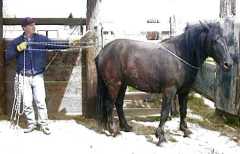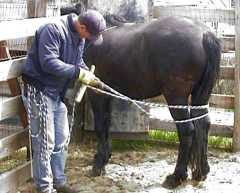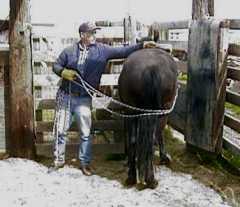The Sliding Neck Loop
| ||||||||||||||||
|
Important Note!
Some of these sequences were photographed decades ago before we participated in a helmet safety study. The results of the study were impressively conclusive. Since 1998 we always wear approved helmets when training and handling horses. Once you start to get handy with the sliding neck loop, there are variations as to how you can use it. The photos presented here were taken during the first two hours of contact with this stocky 6 year old BLM (recently gelded) stallion. |
|
You can split the lines holding the loop in one hand and the running end in the other hand and actually ground drive a horse, getting him used to feeling the ropes acress his back and slapping him slightly with the rope to get him to move forward. This can help generate a response before the horse can be haltered or bitted, although it is best used in a small enclosure as steering can be a little difficult. One key point is to make the loop long enough that you are out of kicking range in case the horse spooks at the contact of the rope! |
Ground Driving with the Loop
|
|
The lines can be used to get a horse used to having things against his hind legs. If he does strike out at the ropes, he's not going to hurt anyone. The art here is to move the ropes slowly so he gets used to the feel and is not inclined to "kick the rope away." |
Getting the horse used to
|
|
The lines can be used to encourage the horse to stand fast while being touched and rubbed. The idea here is not to force the horse into a confined space as that will only generate stress and possibly trigger a flight or fight response. What we want to do is give the horse something to think about and discourage him from backing up, therefore consciously dealing with our contact. |
Standing quietly while I
|
Please note: Some horses will kick at ropes touching their hind legs. Avoid any situations that could place you in kicking range in the event a rope or other object surprises a horse and he kicks! | |
Press "Back" to return to the page that brought you hereGo to Case Study SectionReturn to Training SectionReturn to Wild Horse MentorsReturn to KBR World of Wild Horses and BurrosGo To
|



